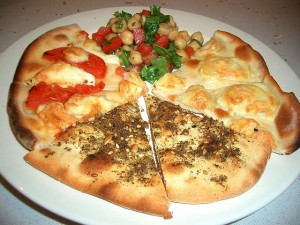
In my post Because Wine Not from my Meet the Expat Series, I talked to Amanda about her experience as a teenager in Japan. As she retells her first night meeting her host family in Tokyo she remembers, “They ordered Pizza Hut to make me feel like home…”
“Awww,” I say, laughing at the humor and familiarity of it all and thinking Sure…of course…pizza. It’s so American (at least for a New Yorker) but universal at the same time. It led me to my next thought. The old idea that although we are from different places, we are not as different as we think.
But before I could voice that thought she continues, “…except the pizza came with tuna and corn and octopus on it and I thought I was going to die.”
That brilliant epiphany I thought I just had got smacked in the back of the head. Doof! We kind of are that different. I had assumed it would be the same – it’s pizza: crust, sauce, cheese. Simple. But even something seemingly basic, something like pizza, varies everywhere you go.
So which is is?
Are we that different or are we not?
Perhaps, it’s both.
There is no doubt that we all live within the same universal boundaries of human life but the details within those boundaries are what make us different. Same pizza, different toppings. Our common fabric keeps us united while the small threads are what divide us. Turns out pizza and culture could teach us a lot.
Communication
Communication is important in the human species. We are pack animals and have depended on one another for protection, camaraderie, and livelihood since the days of cavemen. Both verbal and non-verbal communication is essential to our way of life; no one can argue that. Communication is that common fabric. But how we communicate are the threads that divide.
In the U.S., you might greet another person with a handshake or wave.
In France, most people greet with the double cheek kiss.
In Paris specifically, many greet with the four cheek kiss.
In Belgium, the cheek kiss depends on your age. Someone your age or younger would receive one kiss while someone older would be given three.
Even within countries the common fabric is divided by threads.
Eating Customs
Food and eating is also a common fabric. What culture do you know that doesn’t have major traditions, rituals, and manners surrounding mealtimes? But take a deeper look into this fabric and you’ll see the diverse threads that hold it together. Proper manners in one country might translate into rudeness in another. Yummy dishes in one place are yucked at in another.
In traditional India, eating was considered an experience for all of the senses so food was eaten with your hands. Unless it was soup… that would just be silly and sloppy.
In Saudi Arabia, burping after your meal shows you enjoyed it.
In Japan, passing food from chopstick to chopstick is a huge no-no because in traditional Japanese funerals, relatives of the deceased use chopsticks to pass cremated remains to each other as I learned from Amanda’s experience.
In Thai culture, you might use a fork… to help push your food onto a spoon which is the utensil used to eat your food.
Emotion Displays
The way we display or communicate emotion is based on our social and cultural expectations. Basically, while we all share the same human emotions how we express these emotions is, you guessed it, part of the thread that makes us different.
In Thai culture, complaining – about anything – can be considered offensive. If you’re cold, wear a sweater. If you’re hungry, get a snack. Keep your complaining to yourself.
In the U.S., complaining about the weather might be a way to bond with someone.
In Japan, expressing negative emotion in front of an authority figure is considered rude. People will mask their feelings and keep their face neutral to avoid showing any negativity.
Pizza
To tie it back to where this all started, let’s bring it back to the “simple” pizza because it is this simple: we know what we know because we know it. We don’t find it strange that people eat a fungus on their pizza pie because mushrooms are one of the most popular toppings on the American pie. The host family that hosted Amanda didn’t find it strange to top their pizza with tuna because that might be the most popular topping in Japan.
In Brazil, green peas top the list of toppings.
In Australia, shrimp, pineapple and BBQ sauce made the cut.
In Costa Rica, coconut pizza is what’s for dinner and
In the Netherlands, the “Double Dutch” (double meat, cheese, and onion) are what’s ordered.
So what’s more important: The Fabric or Thread?
It’s true that if I had never eaten pizza before and then ate a pizza with anchovies and green beans on it, I would probably say I didn’t like pizza as opposed to saying I don’t like anchovies or green beans. People that are fearful of dogs are not necessarily fearful of my small poodles – one of which barely has any teeth left. They are fearful of the dog that bit them when they were 9½ or the large, ominous dog that snarls its teeth and barks every morning. We (I) tend to clump things together.
 Sure the individual threads count. It is in each of these threads that the fabric is woven. But each thread on its own doesn’t amount to much unless it is to strengthen the whole.
Sure the individual threads count. It is in each of these threads that the fabric is woven. But each thread on its own doesn’t amount to much unless it is to strengthen the whole.
We are so different. Each cultural thread a different color, a different texture, a different pattern, a different material. We could cling to those differences or we could realize that by adding threads of different colors, textures, patterns, and materials we make a fabric brighter and stronger than any one of those threads can make alone.
When we moved to Dominican Republic we noticed that corn was a popular topping here. Not much later, we visited a pizzeria where many of their pizza pies included an egg on top. We finally gave in one day and ordered the egg pizza. Gotta tell you, you won’t know you like something different until you try.
~Pack lightly. Live well. Move often. Repeat.~ Picture Credits:
Pepporoni – Jeffrey W
Margherita Pizza – Samat Jain
Mediterranean Pizza – Alpha
Picture Credits:
Pepporoni – Jeffrey W
Margherita Pizza – Samat Jain
Mediterranean Pizza – Alpha

